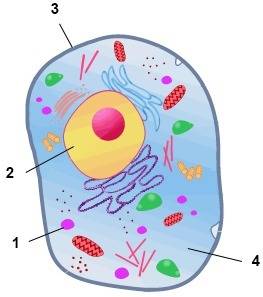The answer is D.
Modification of protein is done by the Golgi apparatus of the cell and not the nucleus. The nucleus simply has the blue print of proteins and releases these blue prints to mRNA which transports the prints out to the ribosomes where they are read and used to synthesize or make the protein.
Once a protein has been made, it is packed into a vesicle which is a "shipping envelope" for a cell. The vesicle moves to the Golgi apparatus which receives it and enzymes within the apparatus modify the vesicle contents, that is the protein, to its final form. The protein is then repacked into a new vesicle which then migrates from the Golgi apparatus to the cell membrane and releases the protein to the outside of the cell.
The answer is D.
Modification of protein is done by the Golgi apparatus of the cell and not the nucleus. The nucleus simply has the blue print of proteins and releases these blue prints to mRNA which transports the prints out to the ribosomes where they are read and used to synthesize or make the protein.
Once a protein has been made, it is packed into a vesicle which is a "shipping envelope" for a cell. The vesicle moves to the Golgi apparatus which receives it and enzymes within the apparatus modify the vesicle contents, that is the protein, to its final form. The protein is then repacked into a new vesicle which then migrates from the Golgi apparatus to the cell membrane and releases the protein to the outside of the cell.
 16
16 c
Explanation:
got it wrong on here and it said that
C.
Structure 2 is the nucleus, which serves as the control center of the cell.
 1
1  13
13 
 13
13 
 16
16 c
Explanation:
got it wrong on here and it said that
C.
Structure 2 is the nucleus, which serves as the control center of the cell.
 4
4 15. The correct answer is option C, that is, made up of cells. All the living things are made up of cells.
16. The correct answer is option D, as mitochondria are considered as the powerhouse of the cell.
17. The correct answer is option B, the prime function of the cell wall is to provide the cell strength, strength, and composition.
18. The correct answer is option C, the cell membrane works as a gatekeeper of the cell, it monitors the movement of components in and out of the cells and organelles. In this manner, it is selectively permeable to organic molecules and ions.
19. The correct answer is option C, the Kingdom Plantae comprises of species like trees, bushes, herbs, grasses, green algae, and others. They are characterized by the presence of cell wall and green chloroplasts.
20. The correct answer is option B, cytoplasm refers to the jelly-like fluid, which fills a cell. It comprises majorly of water and salt. It is present inside the cell membrane of all the kinds of cells and comprises all the cell components and organelles.
 4
4 15. The correct answer is option C, that is, made up of cells. All the living things are made up of cells.
16. The correct answer is option D, as mitochondria are considered as the powerhouse of the cell.
17. The correct answer is option B, the prime function of the cell wall is to provide the cell strength, strength, and composition.
18. The correct answer is option C, the cell membrane works as a gatekeeper of the cell, it monitors the movement of components in and out of the cells and organelles. In this manner, it is selectively permeable to organic molecules and ions.
19. The correct answer is option C, the Kingdom Plantae comprises of species like trees, bushes, herbs, grasses, green algae, and others. They are characterized by the presence of cell wall and green chloroplasts.
20. The correct answer is option B, cytoplasm refers to the jelly-like fluid, which fills a cell. It comprises majorly of water and salt. It is present inside the cell membrane of all the kinds of cells and comprises all the cell components and organelles.
 1
1 Known as the cell's “command center,” the nucleus is a large organelle that stores the cell's DNA (deoxyribonucleic acid). The nucleus controls all of the cell's activities, such as growth and metabolism, using the DNA's genetic information.

It will provide an instant answer!
